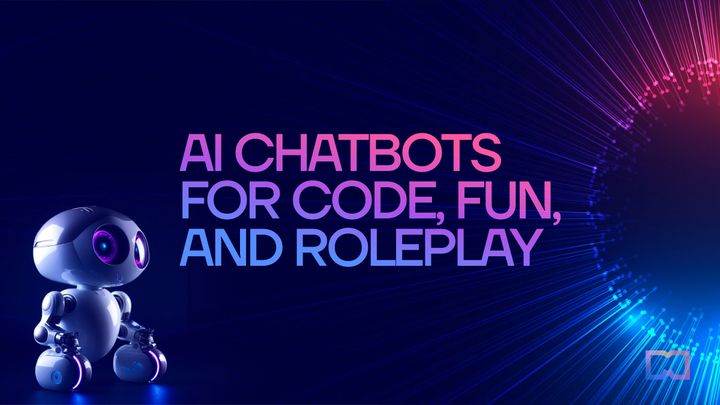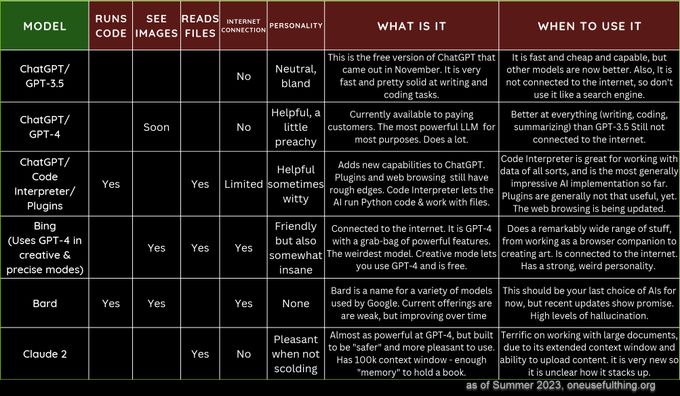Best 5 AI Chatbots for Code, Fun, and Roleplay in 2023: Comparison Sheet


GPT-4 provides even more advanced capabilities, outperforming its predecessors in natural language understanding and generation. Its improved contextual understanding and coherence make it an effective tool for a variety of applications, including automated writing, virtual assistants, and even creative storytelling.
| Pro Tips |
|---|
| These AI telegram chatbots are equipped with advanced AI technology that allows them to simulate human-like conversations and provide personalized responses to users. |
| Read more about AI chatbots that can help businesses reduce costs, increase efficiency, and improve customer satisfaction by providing 24/7 support and personalized interactions. |
| These 10 Uncensored AI Art Generatorsare utilize AI to create stunning and provocative artwork. |

Comparison Sheet of AI Chatbots for Code, Fun, and Roleplay
From GPT-1 to GPT-4, these models have showcased significant advancements in natural language processing and generation. While GPT-1 laid the foundation, subsequent iterations like GPT-4 have demonstrated remarkable capabilities in understanding context and generating coherent responses.

1. ChatGPT / GPT-3.5
- Runs Code: No
- Runs Fun: No
- Runs Roleplay: No
- Sees Images: Neutral
- Reads Files: Limited
- Pros: This is the free version of ChatGPT that was released in November. It’s speedy and budget-friendly, excelling in tasks like writing and coding. It’s not connected to the internet, so users shouldn’t treat it as a search engine.
- When to Use: While other models might offer advanced features, this version is ideal for users who want a basic, reliable, and disconnected chatbot.
2. ChatGPT / GPT-4
- Runs Code: Soon
- Runs Fun: Yes
- Runs Roleplay: Yes
- Sees Images: No
- Reads Files: Limited
- Pros: Available to paying customers, Pens is a power-packed model, superior in writing, coding, and summarizing compared to its predecessor, GPT-3. It is not internet-connected, ensuring user data privacy.
- When to Use: When you need an AI superior to GPT-3 in various tasks but still not connected to the internet.
3. ChatGPT / Code Interpreter
- Runs Code: Yes
- Runs Fun: Yes
- Runs Roleplay: Yes
- Sees Images: Yes
- Reads Files: Limited
- Pros: This model introduces new capabilities to ChatGPT. It’s adept at tasks like coding interpretation and web browsing. Although web browsing capabilities are still in their infancy, the potential is evident. Furthermore, it can run Python code and work with files, making it versatile.
- When to Use: When you need a mix of coding and browsing capabilities. It is particularly impressive in its current implementation.
4. Bing / GPT-4
- Runs Code: Yes
- Runs Fun: Yes
- Runs Roleplay: Yes
- Sees Images: Yes
- Reads Files: Yes
- Pros: A unique model that blends GPT-4’s capabilities with a range of powerful features. Whether you want a browser companion or an art creator, this model has got you covered. It’s connected to the internet and offers a peculiar blend of creativity and precision.
- When to Use: For diverse tasks ranging from browsing to art creation. Users looking for a blend of creativity and exactness will find this model appealing.
5. Bard
- Runs Code: Yes
- Runs Fun: Yes
- Runs Roleplay: Yes
- Sees Images: Yes
- Reads Files: Yes
- Pros: Bard is a collective name for various models used by Goose. While current offerings may have some limitations, recent updates hint at a promising future. Notably, it exhibits high levels of hallucination.
- When to Use: As of now, Bard should be a secondary choice, but keep an eye on this one as it’s showing rapid improvements.
6. Claude 2
- Runs Code: Yes
- Runs Fun: Yes
- Runs Roleplay: Yes
- Sees Images: No
- Reads Files: When not scolding
- Pros: Almost as powerful as GPT, this model is designed to offer a safer and more pleasant user experience. It has an extended context window, making it apt for working with large documents. Its ability to upload content is a bonus.
- When to Use: Ideal for users handling voluminous documents and those who prioritize user experience alongside power.
Each model in the GPT series offers unique capabilities, ensuring there’s something for everyone. As technology advances, we can only anticipate more refined and versatile offerings in the AI chatbot domain.
How to Activate Roleplay with ChatGPT or Bard
OpenAI’s latest innovation, GPT-4, has recently introduced a feature that many enthusiasts had been eagerly awaiting: roleplay models with prerecorded instructions. Now, not only can users converse with the AI, but they can also direct its persona, making the interactions even more dynamic.
To activate roleplay with ChatGPT or Bard, users need to dive into the settings. Under ‘Beta features’, there’s an option to opt into ‘Custom instructions’.

Imagine wanting your chatbot to respond with poetic verses in French or wishing for it to embody the witty and sarcastic style of Glados from the popular game Portal. With GPT-4, all this and more is possible.

After a quick page reload, a separate button appears in the menu, opening the door to a world of Sci-Fi styled interactions. Fancy a conversation with HAL 9000 from ‘2001: A Space Odyssey’ or the logical TARS from ‘Interstellar’? GPT-4 has got you covered.
For those eager to dive into futuristic conversations, there are preloaded prompts available. These not only guide GPT-4’s responses but transport users into their favorite Sci-Fi worlds, making the chat experience truly out of this world.
GPT-4’s Diverse Applications
One of the standout features of GPT-4 is its ability to operate in multiple modes. The ‘Creative Mode,’ for instance, allows users to harness the power of GPT-4 in innovative ways. Whether it’s generating art, assisting in web browsing, or serving as a digital companion, GPT-4’s creative mode showcases a blend of power and versatility that is both impressive and sometimes even unpredictable.
For developers and coders, GPT-4 offers a ‘Code Interpreter’ mode. This is particularly useful for programming tasks, allowing the model to interpret code, assist in debugging, and even provide coding solutions. The integration of Python code and file interaction amplifies its utility for technical tasks.
Moreover, with the integration of plugins, GPT-4 can execute Python code and work with files, making it a powerful tool for a wide range of professional applications.
The Future of GPT Models
As of summer 2023, the GPT models continue to evolve. The recent offerings, like ‘Bard,’ showcase OpenAI’s commitment to refining and expanding the capabilities of these AI-driven systems. While they may currently exhibit certain limitations, such as occasional hallucinations or incoherent outputs, continuous updates promise better performance and fewer quirks.
FAQs
Users can enable this feature by going to settings, selecting ‘Beta features’, and opting into ‘Custom instructions’.
Yes, GPT-4 can emulate the style of characters like Glados from Portal, EDI from Mass Effect, HAL 9000, and TARS from Interstellar, among others.
Absolutely! With the new feature, users can set the desired format of answers, including responding with French verses.
The roleplay model in ChatGPT / GPT-4 offers more dynamic interactions, allowing users to dictate the AI’s persona and style of response.
It transforms static and predictable chatbot responses into versatile, adaptable, and personalized interactions, enhancing user engagement.
While ChatGPT comes with preloaded prompts, it’s designed to be versatile, so users can certainly try guiding it to assume different personas or styles.
Read more related topics:
Disclaimer
In line with the Trust Project guidelines, please note that the information provided on this page is not intended to be and should not be interpreted as legal, tax, investment, financial, or any other form of advice. It is important to only invest what you can afford to lose and to seek independent financial advice if you have any doubts. For further information, we suggest referring to the terms and conditions as well as the help and support pages provided by the issuer or advertiser. MetaversePost is committed to accurate, unbiased reporting, but market conditions are subject to change without notice.
About The Author
Damir is the team leader, product manager, and editor at Metaverse Post, covering topics such as AI/ML, AGI, LLMs, Metaverse, and Web3-related fields. His articles attract a massive audience of over a million users every month. He appears to be an expert with 10 years of experience in SEO and digital marketing. Damir has been mentioned in Mashable, Wired, Cointelegraph, The New Yorker, Inside.com, Entrepreneur, BeInCrypto, and other publications. He travels between the UAE, Turkey, Russia, and the CIS as a digital nomad. Damir earned a bachelor's degree in physics, which he believes has given him the critical thinking skills needed to be successful in the ever-changing landscape of the internet.
More articles

Damir is the team leader, product manager, and editor at Metaverse Post, covering topics such as AI/ML, AGI, LLMs, Metaverse, and Web3-related fields. His articles attract a massive audience of over a million users every month. He appears to be an expert with 10 years of experience in SEO and digital marketing. Damir has been mentioned in Mashable, Wired, Cointelegraph, The New Yorker, Inside.com, Entrepreneur, BeInCrypto, and other publications. He travels between the UAE, Turkey, Russia, and the CIS as a digital nomad. Damir earned a bachelor's degree in physics, which he believes has given him the critical thinking skills needed to be successful in the ever-changing landscape of the internet.























































